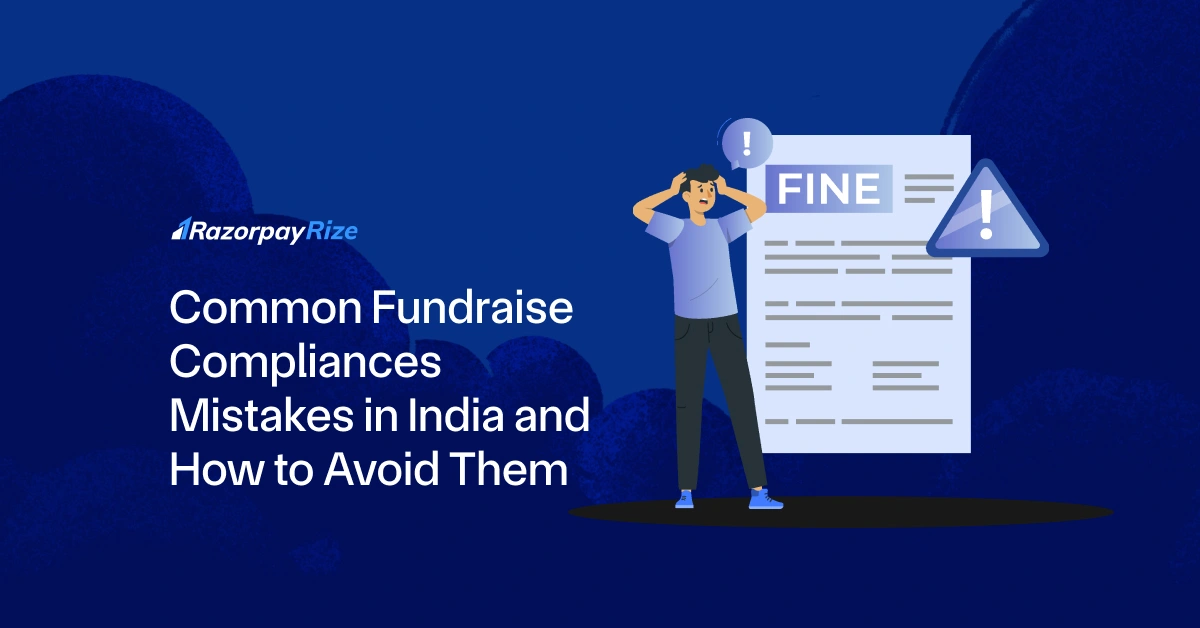Fundraising is a defining milestone that often shapes a startup's future. For founders in India, securing external funding can unlock new markets, accelerate product development, and attract the right talent. But in the race to pitch to investors and close deals, many founders tend to sideline one crucial aspect: compliance.
Investors today conduct rigorous due diligence before committing funds. A single compliance gap can trigger red flags, delay funding, or worse—lead to deal cancellations. Moreover, non-compliance can expose your startup to penalties, regulatory scrutiny, and reputational damage that could hinder future fundraising efforts.
This blog sheds light on some of the most common fundraising compliance mistakes founders in India make and practical ways to avoid them.
Table of Contents
Lack of a Clear Value Proposition
A strong value proposition is the foundation of any successful fundraising pitch. Yet, many founders struggle to explain what truly sets their startup apart. VCs in India often report that over 60% of the pitches they reject fail at this first hurdle. Investors aren't just backing ideas—they're investing in solutions that address real market needs with a clear, defensible growth path.
The Impact:
- A weak or generic value proposition makes it hard for investors to see the potential for a 10x-100x return on investment.
- It raises doubts about the founder’s understanding of the market. An average investor spends less than three minutes reviewing a pitch deck; a confusing message means instant rejection.
How to Avoid It:
- Articulate your Problem-Solution Fit: Quantify the problem. Instead of "we help SMEs digitize," say "we help India's 63 million SMEs reduce their average monthly accounting overhead by 30%."
- Highlight Unique Differentiators: Is it your proprietary tech, an exclusive partnership, a revolutionary business model (e.g., unique GTM strategy for Tier-2/3 cities), or a founding team with deep domain expertise from a relevant unicorn?
- Keep it Concise: Practice a 30-second elevator pitch that clearly states the problem, solution, target market, and secret sauce.
Underestimating Market Size and Competition
Many founders present overly optimistic market size estimates, often citing a massive, irrelevant TAM. Investors quickly pick up on these gaps, which signal poor research and a weak business strategy.
The Impact:
- Claiming the entire $150 billion Indian retail market for a niche D2C fashion brand erodes credibility instantly.
- Ignoring direct and indirect competitors shows a lack of preparedness. An investor will likely know the competitive landscape better than you.
How to Avoid It:
- Use Credible Data: Back your market estimates with data from sources like NASSCOM, Bain & Company, Inc42, Tracxn, or government reports (e.g., Economic Survey of India).
- Present a Clear TAM, SAM, SOM:
- Total Addressable Market (TAM): The total market demand (e.g., The entire Indian EdTech market, valued at $29 billion by 2030).
- Serviceable Available Market (SAM): The segment you can target (e.g., K-12 test prep market in India, estimated at $10 billion).
- Serviceable Obtainable Market (SOM): What you can realistically capture in 3-5 years (e.g., 1-2% of the SAM, representing a $100-$200 million revenue opportunity).
- Showcase Competitive Analysis: Create a competitive matrix that maps key players against features, pricing, and market share. Clearly articulate your unique edge.
Insufficient Due Diligence on Investors
In the rush to secure funding, many startups forget that an investor-founder relationship is a long-term partnership, often lasting 7-10 years. Not every investor is the right fit for your business.
The Impact:
- Misaligned goals can lead to conflict. An investor seeking a quick 2-year exit will clash with a founder building for long-term market leadership.
- Some investors carry reputational risks or have a portfolio full of conflicting companies, which can harm your business.
How to Avoid It:
- Research Investor Portfolios: Use platforms like Tracxn or Crunchbase to see their past investments, sector focus, typical cheque size, and involvement level.
- Conduct "Reverse Due Diligence": Talk to at least 2-3 founders from their portfolio. Ask about their experience, the value-add beyond capital, and how the investor behaves during challenging times.
- Ensure Vision Alignment: Discuss your long-term vision, potential exit scenarios, and governance expectations before signing the term sheet.
Poor Financial Projections
Financial projections aren’t just numbers on a slide—they're a reflection of your business acumen. Investors expect thoughtful, data-driven projections that are realistic and achievable.
The Impact:
- Projecting 100% month-on-month growth for 36 months without validated unit economics (CAC, LTV) is a major red flag.
- Unrealistic forecasts that show profitability in six months for a deep-tech R&D startup diminish trust in your planning abilities.
How to Avoid It:
- Build Bottom-Up Projections: Base your forecasts on key drivers: marketing spend, conversion rates, sales team efficiency, production capacity, and churn rates.
- Show Key Metrics: Clearly state your assumptions for Customer Acquisition Cost (CAC), Lifetime Value (LTV), Churn Rate, and Monthly Burn Rate. A healthy LTV/CAC ratio (ideally >3:1) is a strong positive signal.
- Present Scenarios: Show a baseline (most likely), an optimistic, and a conservative case. This demonstrates strategic thinking.
Ignoring Legal and Regulatory Compliance
This is one of the most critical and overlooked areas. Non-compliance with Indian regulations can kill a deal during due diligence.
The Impact:
- Legal and compliance issues are a leading cause for fundraising delays, with 25-30% of deals facing hurdles at the due diligence stage due to poor documentation.
- Non-compliance with the Companies Act, 2013, or FDI norms can lead to hefty penalties, voiding of share allotment, or even criminal proceedings.
How to Avoid It:
- Maintain a "Virtual Data Room" (VDR): Keep all documents audit-ready. This includes:
- Corporate Documents: Certificate of Incorporation, Memorandum of Association (MoA), Articles of Association (AoA).
- Secretarial Records: Up-to-date statutory registers, board minutes, and shareholder resolutions.
- Cap Table: A clean, accurate capitalization table. Any discrepancy here is a major red flag.
- IP: All intellectual property assignments from founders, employees, and consultants are properly documented.
- Employee Documentation: Compliant employment agreements and a properly structured and approved Employee Stock Option Plan (ESOP).
- Comply with FDI Regulations: If raising from foreign investors, ensure compliance with FEMA (Foreign Exchange Management Act) regulations, including sectoral caps, pricing guidelines, and timely reporting to the RBI through the FIRMS portal (Form FC-GPR must be filed within 30 days of share allotment).
- Engage Professionals: Work with a qualified Company Secretary (CS) and a corporate lawyer from day one. The cost is negligible compared to the cost of a failed funding round.
Overvaluing Your Startup
An inflated valuation without the backing of strong metrics can scare off investors. The Indian market has seen valuation corrections, with late-stage valuations dropping by 20-25% in 2023.
The Impact:
- A high valuation sets unrealistic expectations, making future rounds difficult and increasing the risk of a "down round," which demoralizes employees and signals distress to the market.
- For a pre-revenue idea, asking for a ₹50 Crore ($6 million) valuation will likely get you laughed out of the room. A typical Indian idea-stage valuation is in the ₹5-15 Crore ($0.6M - $1.8M) range.
How to Avoid It:
- Benchmark Your Valuation: Research recent deals in your sector and stage in India. A seed-stage SaaS startup with ₹1 Crore ($120k) in ARR might command a valuation between ₹10-20 Crore (10x-20x ARR), not ₹100 Crore.
- Focus on Building Value: Traction speaks louder than projections. Show month-on-month growth in users, revenue, or engagement before demanding a premium valuation.
- Be Negotiable: Use convertible instruments like iSAFE notes (India Simple Agreement for Future Equity) to defer the valuation discussion to a later, metrics-backed round.
Focusing Solely on Equity Funding
Equity isn't the only option. India's venture debt market has grown significantly, with over $1.2 billion disbursed in 2023. Overlooking alternatives can lead to unnecessary dilution.
The Impact:
- Selling 20-25% of your company at the seed stage can lead to founders having less than 50% ownership by Series A, reducing their control and motivation.
- You may be missing out on non-dilutive capital that is better suited for your needs (e.g., funding inventory).
How to Avoid It:
- Explore Venture Debt: If you have predictable revenue streams, venture debt can fund working capital or marketing expenses with minimal dilution (1-2% warrant coverage vs. 20% equity).
- Look into Grants and Government Schemes: Investigate programs like the Startup India Seed Fund Scheme (SISFS), SIDBI Fund of Funds, and various state-level grants that provide capital without taking equity.
- Consider Revenue-Based Financing: For businesses with recurring revenue (SaaS, D2C subscriptions), platforms offer capital in exchange for a percentage of future revenue, with no equity dilution.
Rushing the Fundraising Process
Fundraising is a marathon, not a sprint. The pressure to secure capital often leads to a rushed process, resulting in bad deals or missed opportunities.
The Impact:
- A rushed pitch appears unprofessional and unprepared. Investors can sense desperation.
- Founders often accept the first term sheet they receive, which may have predatory clauses (e.g., aggressive liquidation preferences, broad veto rights).
How to Avoid It:
- Plan for a 4-6 Month Cycle: The average fundraising process in India, from the first outreach to money in the bank, takes 4-6 months. Start well before your cash runs out.
- Prepare a Target List: Research and build a list of 50-100 relevant investors. Fundraising is a numbers game. You might need 100+ conversations to get 1-2 term sheets.
Build Relationships Early: Don't reach out to investors only when you need money. Connect with them on LinkedIn, share updates, and seek advice months in advance. A warm introduction from a trusted source increases your chance of getting a meeting by over 10x.
Private Limited Company
(Pvt. Ltd.)
- Service-based businesses
- Businesses looking to issue shares
- Businesses seeking investment through equity-based funding
Limited Liability Partnership
(LLP)
- Professional services
- Firms seeking any capital contribution from Partners
- Firms sharing resources with limited liability
One Person Company
(OPC)
- Freelancers, Small-scale businesses
- Businesses looking for minimal compliance
- Businesses looking for single-ownership
Private Limited Company
(Pvt. Ltd.)
- Service-based businesses
- Businesses looking to issue shares
- Businesses seeking investment through equity-based funding
One Person Company
(OPC)
- Freelancers, Small-scale businesses
- Businesses looking for minimal compliance
- Businesses looking for single-ownership
Private Limited Company
(Pvt. Ltd.)
- Service-based businesses
- Businesses looking to issue shares
- Businesses seeking investment through equity-based funding
Limited Liability Partnership
(LLP)
- Professional services
- Firms seeking any capital contribution from Partners
- Firms sharing resources with limited liability
Frequently Asked Questions
What Documents Are typically required during a Fundraising Round in India?
When raising funds in India, especially from institutional investors or sophisticated angels, startups are expected to present a set of key documents. The typical documents include:
- Pitch Deck
- Business Plan/Model Document
- Financial Statements
- Projections/Financial Model
- Cap Table
- Company Incorporation Documents
- Shareholder Agreements (if any)
- Legal & Regulatory Compliance Documents
What Is a Term Sheet and Why Is It Important?
A Term Sheet is a non-binding document that outlines the key terms and conditions under which an investor agrees to invest in a startup. It typically covers:
- Valuation
- Investment Amount
- Equity Stake
- Investor Rights (Board Seats, Information Rights)
- Liquidation Preference
- Anti-Dilution Provisions
- Exit Clauses
It sets the negotiation framework before drafting the final legal agreements and helps both parties align on expectations, rights, and obligations.
How Much Equity Should a Startup Give Away in the First Round of Funding?
There’s no fixed percentage, but most early-stage startups in India dilute anywhere between 10% to 25% in their first funding round (usually seed or pre-seed).
How Long Does the Fundraising Process Usually Take?
The typical fundraising cycle, from initial outreach to money in the bank, can take 3 to 6 months, sometimes longer, depending on factors like market conditions, founder network, startup stage, etc.
What Is a Convertible Note and How Is It Different from Equity?
A Convertible Note is a debt instrument that converts into equity at a future date, typically during a priced funding round. Startups often use convertible notes in early rounds like seed funding to delay valuation discussions.
A convertible note differs from direct equity because it starts as a debt instrument and later converts into equity, typically during a future funding round. Unlike equity—where investors immediately receive shares based on a set valuation—convertible notes allow startups to raise funds without determining the company’s valuation upfront.
















